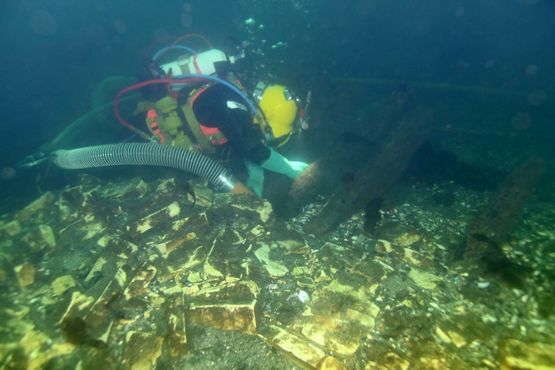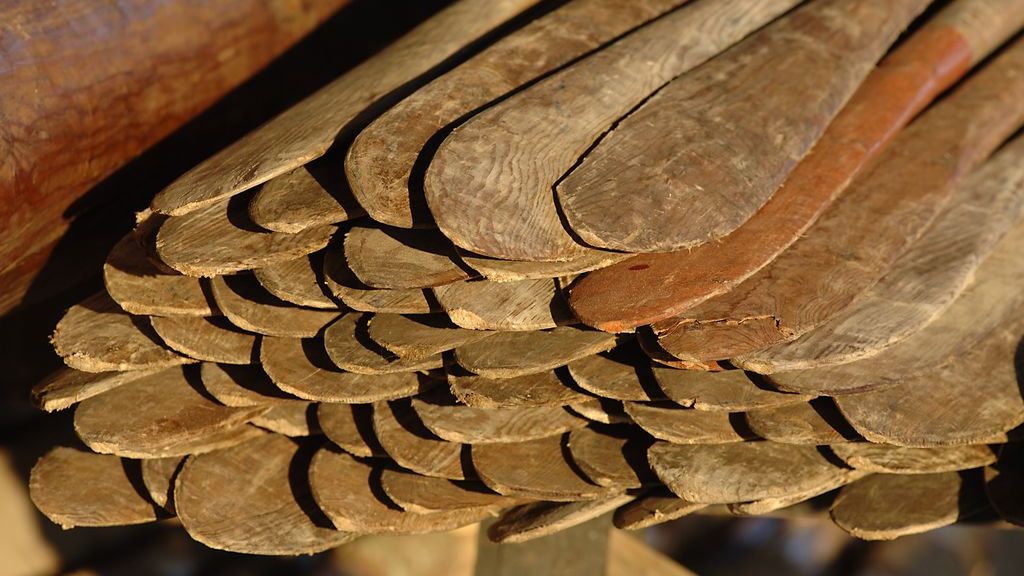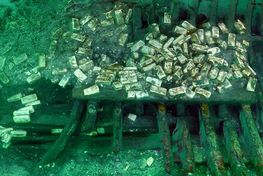After lying hidden and forgotten on the seabed for centuries, these two ships saw the light of day again in 2023. The ships were discovered in the channel called Svælget, which the urban development company, ‘CPH City and Port Development, needed to deepen and reshape as part of establishing the artificial peninsula, Lynetteholm.
During the spring and summer of 2023, maritime archaeologists from the Viking Ship Museum conducted complex and extensive underwater excavations of the shipwrecks. Piece by piece, the ships were subsequently lifted from the seabed and transferred to the Viking Ship Museum in Roskilde.
One might think that the work is over for maritime archaeologists, but now the extensive documentation work awaits, aiming to uncover the stories of these ships.
Join in as archaeologists uncover traces of our collective past
Usually, only a few people get close to the fragile finds from the seabed. However, in contrast to the excavation work itself, it will be possible to get up close to the exciting archaeological process of analyzing and documenting the many ship parts as marine archaeologists open the doors to their documentation workshop in the coming months.
Here, visitors will have a unique opportunity to gain insight into the archaeologists' work and firsthand experience of how new traces of our shared history are unveiled.
Visit the Marine Archaeologists' DocuLab
Opening hours at the Marine Archaeologists' Workshop:
The Marine Archaeologists' Workshop is open to the public every day from 10:00 to 15:30
Archaeologists work in the documentation workshop every weekday from 10:00 to 15:30
Exhibition 'Swallowed by the Sea - two ships that never reached Port:
The exhibition is on display at the Marine Archaeologists' DocuLab and showcases findings from the two excavations, zooming in on the nearly invisible traces that contribute to new knowledge about past sailors, maritime activities, and society.
Get your hands on findings from Lynetteholm:
Workshops for children every weekend and holiday at 11:00 and 12:30.
We owe it to the sailors of the past to be thorough
Every part of the ship's timber will be scrutinized by the archaeologists to ensure that all traces telling the story of the ships and the people who sailed with them are preserved.
The archaeologists hope that their meticulous work will enable them to answer the many questions brought to the surface by the discovery of these two previously unknown ships.
"We owe it to past sailors to investigate all aspects of the ships so that we can gain more insight into the past and the lives of people intricately connected to these ships," explains Morten Johansen, the team leader for maritime archaeology at the Viking Ship Museum.
Each part is digitally measured with a 3D scanner and documented with photos so that ship researchers, now and in the future, can study these exciting finds. Based on the scans, the archaeologists create 3D models that will help determine the shape and size of the ships.
Two unknown ships from Øresund
The two shipwrecks were found in the narrow Svælget channel, close to the coast of Amager. The channel serves as the entrance to Copenhagen from the southern part of Øresund. The Svælget channel needs to be redesigned and deepened as part of establishing the artificial peninsula, Lynetteholm, in the port of Copenhagen. Therefore, it is not possible to preserve the two archaeological ship finds at their original locations.
In CPH City and Port Development, there is great joy that the Viking Ship Museum is now showcasing the finds to the public. CEO Anne Skovbro says:
"In connection with the Lynetteholm construction, it has been important for us to investigate all conditions thoroughly. The Viking Ship Museum has helped us map and illuminate the entire area so we can establish Lynetteholm on an informed basis and preserve the important finds for the future."
Neither of the ships was known before the archaeologists started their work. There are no written accounts telling us which ships they are or explaining why they sank. Hence, the archaeologists named the ships after the channel where they were found: 'Svælget 1' and 'Svælget 2.'
Already during the excavations, the archaeologists determined that Svælget 1 is a smaller cargo ship from the 1800s that sank in a violent shipwreck carrying a large load of yellow bricks. Svælget 2 is a larger and much older ship. Timber dating revealed that the ship was built around 1329, and therefore dates from the Middle Ages.
Small traces can tell significant stories
The goal of the documentation work is to uncover all traces and details on the ship's components. Even microscopic traces can hold new information about how the ships were built and used.
Through this work, the two ship-finds become more than just ship timber and planks. They become new pieces in a complex puzzle that paints the picture of our shared history of people, things, and ships on the move, thus enlightening us about the maritime foundations of our modern society.
Exhibition: Swallowed by the Sea
In the maritime archaeologists' docuLab, visitors can also see the exhibition 'Swallowed by the Sea - two ships that never reached Port.' The focal point of the exhibition is the fatal episodes that sent the ships to the bottom of the sea, bringing us closer to people of the past across centuries:
"The shipwreck is the visible trace of the disaster, captured in a moment. When we can extract specific and human events from history, it helps bring our modern reality and history much closer together," says Morten Johansen, team leader for maritime archaeology at the Viking Ship Museum.
Visit the Marine Archaeologists' DocuLab
Opening hours at the Marine Archaeologists' Workshop:
The Marine Archaeologists' Workshop is open to the public every day from 10:00 to 15:30
Archaeologists work in the documentation workshop every weekday from 10:00 to 15:30
Exhibition 'Swallowed by the Sea - two ships that never reached Port:
The exhibition is on display at the Marine Archaeologists' DocuLab and showcases findings from the two excavations, zooming in on the nearly invisible traces that contribute to new knowledge about past sailors, maritime activities, and society.
Get your hands on findings from Lynetteholm:
Workshops for children every weekend and holiday at 11:00 and 12:30.
Rare ship finds
It is relatively rare for shipwrecks to see the light of day. In fact, archaeological shipwrecks are excavated and recovered from Danish waters only once or twice every 20 years. Shipwrecks are best protected where they are found – on the seabed.
The majority of underwater archaeological excavations occur in connection with construction at sea or along the coast. In most cases, construction work can proceed without disturbing these rare finds, allowing shipwrecks, for example, to be preserved on the seabed after maritime archaeologists have examined and documented them.
In some cases, it is not possible to preserve a shipwreck on the seabed. In such instances, archaeologists must recover the ship so that the find – and the many stories a shipwreck holds – can be preserved for future generations.
Viking Ship Museum and CPH City and Port Development ensure archaeological finds in the port of Copenhagen
Archaeology under the upcoming Lynetteholm:
Before constructing on the sea, the seabed must be examined for traces of the past. Viking Ship Museum maritime archaeologists, along with CPH City and Port Development, conducted thorough investigations of the seabed in the area where the new peninsula, Lynetteholm, is currently being established.
So far, the archaeologists have examined no less than 2,144 positions using a massive 140-ton excavator. The excavator, situated on a barge, has a 21-meter arm that can reach all the way down to the seabed and carefully scoop up samples onto the deck for the archaeologists to examine.
Now, the extensive work of analyzing the results from the preliminary investigations is underway, and during 2024, the archaeologists will conduct follow-up surveys of the seabed.
Archaeology in Svælget:
Archaeologists have excavated two shipwrecks found in 12 meters of water in the Svælget channel. CPH City and Port Development will deepen and reshape Svælget as part of the establishment of the artificial peninsula, Lynetteholm, in the port of Copenhagen.
After being hidden and forgotten on the seabed for centuries, the two ships saw the light of day again in 2023. Part by part, the ships were lifted from the sea bottom and transferred to the Viking Ship Museum in Roskilde, where they will now be analyzed and documented.
The work of documenting the two ship finds will continue until the summer of 2024.




